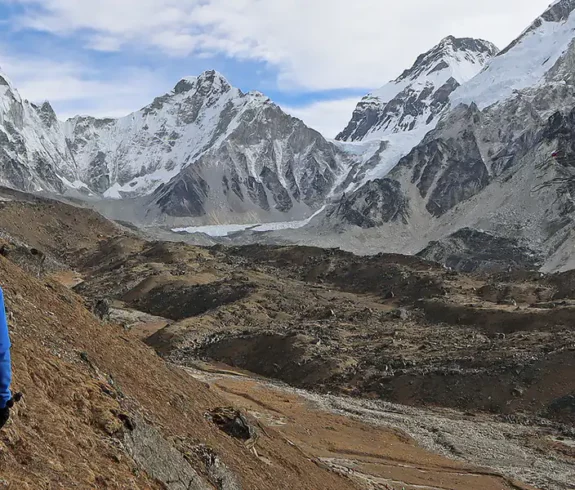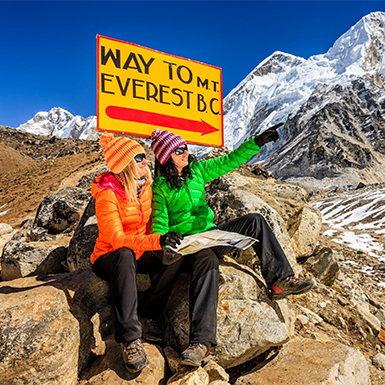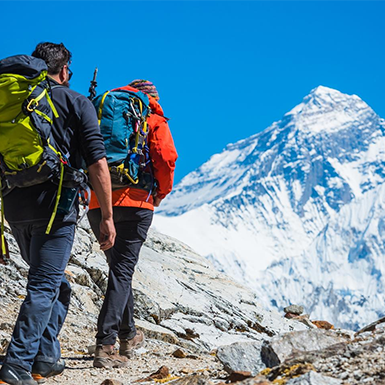Everybody has a dream destination. While some aspire to visit Thailand beaches, others want to go on a shopping spree in London or Paris, and a significant fraction of people wish to tour New York City once in their lifetime. Likewise, other people have been looking forward to visiting Nepal. Similarly, this South Asian country, known for Mount Everest, is also famous for its other natural wonders, such as scenic mountains, highland terraces, and Lake Districts, among many others. Many would rank this beautiful nation number one while making a list of must-go places worldwide, and Everest Base Camp Trekking is one of the finest trekking trails in the World.
Greetings from Peregrine Treks. We have started a series of travel diaries that mention travel information. In this first part, we will be discussing Everest Base Camp Trekking.
A definitive travel guide for Everest Base Camp Trekking will discuss significant subjects like Everest trip features, outline, exercises, licenses, EBC journey trouble, agenda, pressing rundown, food, convenience, elevation ailment, things you ought to do, and things you ought not to do during traveling. By and large, it’s a total Everest Base Camp Trek Guide.
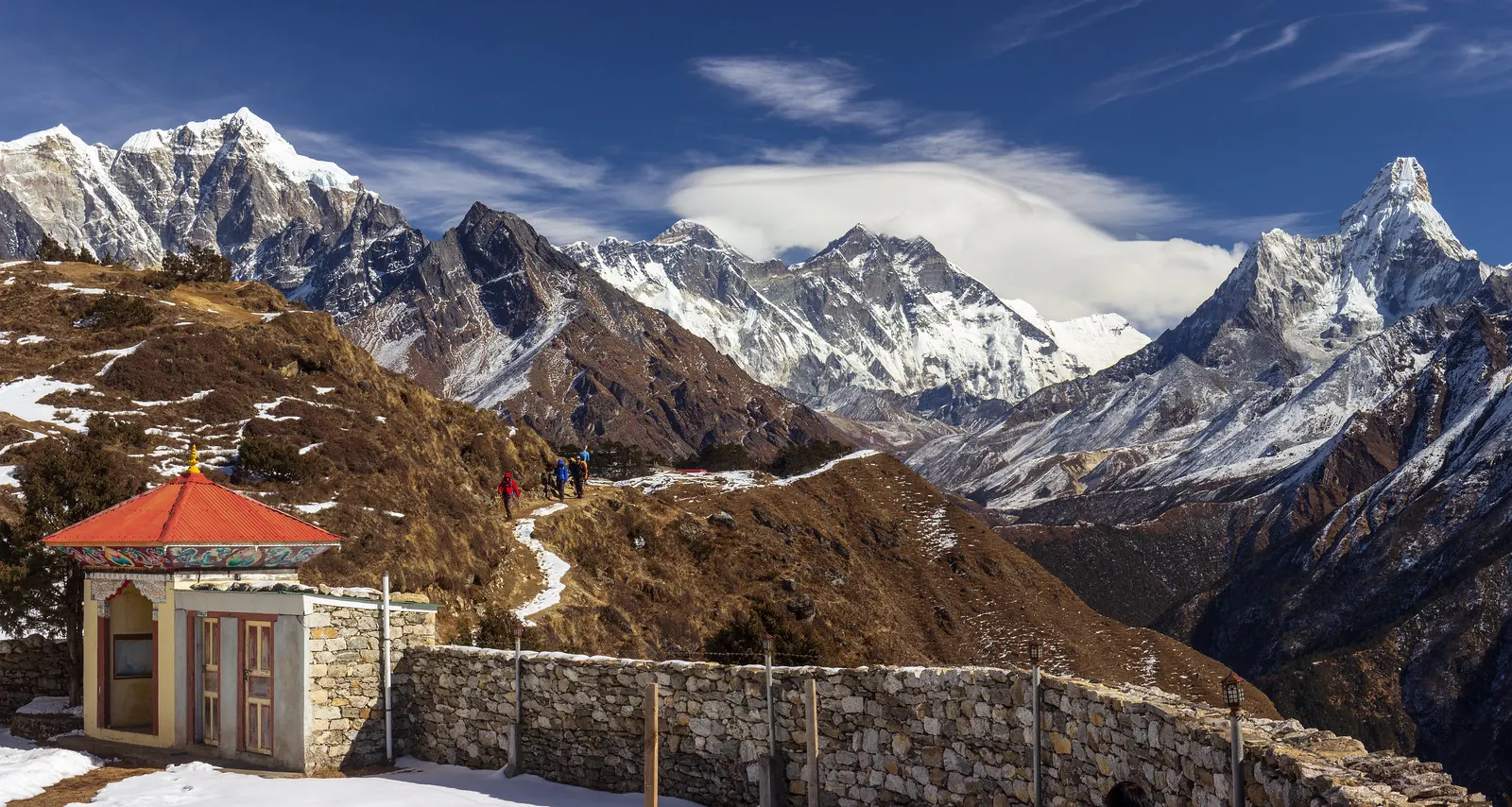
When you think about trekking or hiking, do you wonder where to go? Which countries are best for trekking? I am sure that many people think about these questions, but few of them have good information on the topic of the best places to hike. I have found some excellent articles that describe the best treks in the World. Everest Base Camp Trekking is one of them.
Everest Base Camp Trekking is done between 1,310 to 5,610 meters. The highest place on earth, Everest Base Camp, is appealing due to its seclusion and tranquil environment. Climbing to Mt. Everest Base Camp is an incredible experience that takes you to the world’s most elevated spot, i.e., the headquarters of the world’s most elevated mountain.
Deciding on this excursion is motivation to cheer! For some, it is one dream on their list of must-dos. Furthermore, many international portals have ordered Everest Base Camp Trekking as one of the best trips in the World.
Everest Base Camp Trekking Overview
Everest Base Camp Trekking offers you the opportunity to walk to the foot of Mount Everest, the tallest peak on earth, passing through the beautiful Sherpa country, ancient monasteries, lush forests, and fast-flowing rivers originating from Himalayan glaciers.
Trip Facts:
Country: Nepal
Area: Everest Region
Duration: 15 Days
Group Size: 2-25
Grade: Moderately Difficult
Activity: Walking
Maximum Altitude: 5640m (Kalapatthar)
Minimum Altitude: 1310 (Kathmandu)
Average Walking Hours: 6-7 hours per day
Number of Walking Days: 12
Accommodation: Three-star hotels in Kathmandu; Teahouse during trekking
Start point: Kathmandu
Ending Point: Kathmandu
Trip Highlights:
- Guided full-service trek to the Everest region
- Scenic yet adventurous flight to Lukla
- Opportunity to know about Sherpa culture, tradition, and lifestyle
- Breathtaking views of high Himalayan peaks, including Everest
- Beautiful Sherpa villages of Namche Bazaar and Tengboche
- Ancient Buddhist monasteries
About The Everest Base Camp Trekking
The Everest Base Camp Trekking is a journey of a lifetime for many. The trek has featured numerous international guidebooks, travel shows, and vlogs thanks to its main attraction — Mount Everest, the tallest peak in the World. Because of Everest, the trail may look complicated for many. However, the trek is moderately complex; every fit person can do this trek with proper acclimatization.
As trekkers directly fly into Lukla, they suddenly find themselves in the Buddhist land. One can see prayer wheels, mani walls, and Chhortens throughout the trek, which reflects the rich Buddhist heritage of the region. The walk is easy initially.
The Dudh Koshi River valley trail is scenic, with beautiful villages and lush forests rich in diverse flora and fauna. The trek allows you to meet and interact with Sherpas — the fantastic climbers.
The Mount Everest Base Camp Trekking remains etched in your memory for a long because trekkers walk on the same trail used by Sir Edmund Hillary and Tenzing Norgay Sherpa, the first climbers of Mount Everest, and their climbing party nearly seven decades ago.
Mountain Views:
Though trekkers won’t be able to get good views of the mountains over the first two days of the treks, they find themselves surrounded by mountains on all other days. A scenic Himalayan visa welcomes trekkers no sooner than they climb beyond Namche Bazaar. In some places, they get 360-degree views of high Himalayan peaks. The most dominating peak after Namche is Amadablam, which rises tall above all other peaks.
Similarly, the pyramidical summit of Pumori rises above you as you walk past Dingboche. The panoramic view of tall mountain peaks like Everest, Lhotse, and Nuptse, among others, from Kalapatthar is the icing on the cake.
ROUTE INFO:
The Everest Base Camp Trekking begins with a 40-minute flight to the Lukla airstrip. Furthermore, the trail then passes through the settlements of Chaurikharka and Cheplung to Phakding. It then continues along the Dudh Koshi River to Monjo before climbing to Namche Bazaar. The trail drops to Dudh Koshi River from Namche Bazaar before climbing to Tengboche.
The trail then passes through the beautiful Sherpa settlements of Debuche, Dingboche, and Lobuche to Gorakshep. Gorakshep is the last village on the Everest trail. The return leg begins after a short hike to Kalapatthar Ridge, which offers unhindered views of the high Himalayan peak.
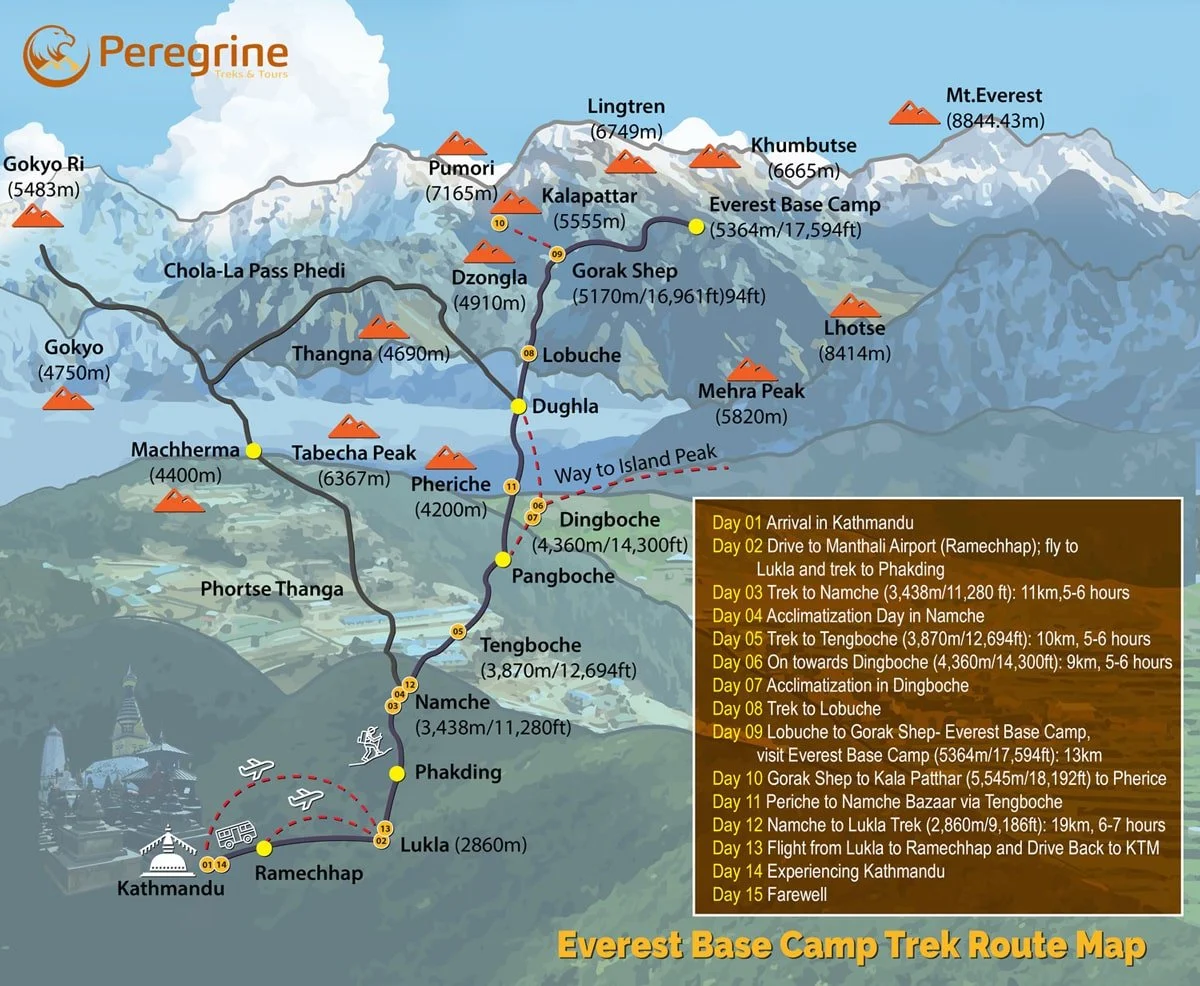
ITINERARY:
Day 1: Arrival in Kathmandu (1310m)
Welcome to Nepal. Our representative will be at the airport to offer you a traditional Nepali welcome and transfer you to your hotel. The remaining time is free for independent activities. In the evening, meet your guide and attend the trek briefing session.
O/N: Hotel
Day 2: Fly to Lukla (2810m), trek to Phakding (2800m) — Approx 40 minutes flight, 4 hrs trek
After breakfast, meet your guide at the hotel, who will transfer you to the airport for a short flight to Lukla. Lukla is the starting point of the Everest Base Camp Trekking. The flight takes about 40 minutes and offers your bird’s eye view of terraced fields, lush forests, and the diverse topography of Nepal. You can also enjoy breathtaking views of the high mountain peaks of the Himalayas as you leave Kathmandu Valley.
Be prepared for the adventurous landing, as many have described Lukla Airport as one of the most challenging airports to land. The slightly inclined airfield sits on a cliff above the Dudhkoshi River valley, leaving pilots no room for error.
Upon arrival in Lukla, meet your crew and wait for them to arrange your loads and begin your trek. As the trail is easy, you will get used to it on the first day. After leaving Lukla, we will walk through the leveled trail of Chaurikharka village and Cheplung before descending to the Dudhkoshi River, which originates in the Khumbu glacier. The trail contours along the left side of Dudh Koshi River as it progresses forward. There are plenty of restaurants and guesthouses on the trek.
We will have lunch in one of them before continuing our trek to Phakding. Look out for mani walls and prayer wheels on the trail, which reflect the fantastic Buddhist heritage of the region. Phakding is a beautiful village located on the banks of the Dudhkoshi River. There are plenty of lodges and teahouses on both sides of the river.
O/N: Teahouse
Day 3: Trek to Namche Bazaar (3440m) — Approx 5-6 hrs
We will resume walking after having breakfast at your teahouse. After crossing the Dudhkoshi River on a suspension bridge, the trail is on the right side of the river. The trail passes through the settlements of Toktok and Bengkar before crossing the river and doing a short climb to Monjo. We will get the first view of Mt. Thamserku from Bengkar. Monjo is a popular stopover on the Everest trail. Some trekkers spend a night here instead of Phakding to climb the uphill trail to Namche Bazaar in the morning. The Sagarmatha National Park area begins from Monjo village. We will show our permits at the national park check post, exit Monjo village, and head toward Namche Bazaar.
There are plenty of ups and downs on the trail. Today, we will gain around 600 meters altitude. We can see caravans of Yaks and Jokyos ferrying supplies to villages lying in the upper areas of the Everest region. A short walk from Monjo will take us to Jorsalle, where we will stop for lunch. After lunch, we will cross the confluence of the Bhotekoshi River on a suspension bridge and start an uphill walk to Namche Bazaar. The winding trail to Namche Bazaar passes through beautiful pine forests.
The walk is challenging, but you will forget your pain after you reach the beautiful village of Namche Bazaar, where we will spend two nights. We will explore the beautiful settlement of Namche Bazaar in the evening. Namche Bazaar has everything that a tourist looks for. There are many coffee shops and bakeries. It even boasts of a discotheque in the high season.
O/N: Teahouse
Day 4: Rest day for Acclimatization
Today, we will take the first rest day of our trip for Acclimatization. Taking a rest day after gaining a certain altitude is necessary as it helps our body acclimate to higher altitudes and prevent altitude mountain sickness (AMS). There are several activities to do to utilize this day. Hike to the twin villages of Kunde and Khumjung, where a school was built by Sir Edmund Hillary, a visit to Sagarmatha National Park Office and Sherpa Museum, and a hike to Everest View Hotel are some options. Your guide will select the appropriate activity for you.
O/N: Teahouse
Day 5: Trek to Tengboche (3890m) — Approx 6 hrs
Fresh after a day’s rest, we will resume our walk after having breakfast at our teahouse. The walk turns complicated from here as the high altitude kicks in. However, the views are rewarding, and you will always see mountains ahead of you. A slight uphill from Namche Bazaar will take us to one of the most scenic walks of the entire trek. We walk on a ridge above the Dudh Koshi River with mountain peaks, including Amadablam, dominating the northern horizon.
We will stop at Kyangjuma (3600m) for lunch. Kyangjuma is a small Sherpa settlement on the Everest trekking trail. After lunch, we will descend the Dudh Koshi River and cross it on a suspension bridge. The final leg of today’s trek is mainly uphill to Tengboche. The magnificent Tengboche Monastery is the main attraction of this small Sherpa village. You can offer prayers to the monster in the evening and interact with young monks. Climbing parties to Everest often make special prayers at the monastery, praying for the success of their expedition.
O/N: Teahouse
Day 6: Trek to Dingboche (4350m) — Approx 5 hrs
After enjoying the sunrise and magnificent mountain views early in the morning, we start our walk toward Dingboche. The trail initially goes downhill to Debuche. It then contours on the right side of the Bhote Koshi River to the settlement of Milinggo. Going further, we will cross the river and walk on the left side to the villages of Pangboche and Shomare, where we will stop for lunch. After lunch, we continue our walk to the confluence of Dudh Koshi and Imja Khola rivers.
We cross the river and follow the Imja Khola River to Dingboche. The trail on the left side of the river goes to the village of Pheriche, where the Himalayan Rescue Association operates a health check post. Both the routes eventually meet at Dough La. However, many trekkers use the route to Dingboche as it promises magnificent mountain views. Imja Khola River originates from Imja Glacial Lake, which lies at the bottom of Imja Glacier of Island Peak.
O/N: Teahouse
Day 7: Rest day for Acclimatization
Today, we will take another rest day to acclimate as we walk above 4,000 meters. There are plenty of activities to make use of this day for Acclimatization. The first option is to hike to Nagarjuna Hill (5050m). Nagarjuna Hill is an excellent viewpoint in Dingboche. The hill offers unhindered views of mountains like Ama Dablam (6812m), Makalu (8485m), and Cho Oyu (8201m), among others. Trekkers are advised to climb to higher altitudes for Acclimatization during rest days, so a hike to Nagarjuna Hill is the best option. But if you do not want to take the ordeal of climbing a hill, you can enjoy a walk to Chukhung village, which lies below the Chhukung, a stopover in the Everest Three Passes Trek. Explore the town and return to Dingboche for lunch.
O/N: Teahouse
Day 8: Trek to Lobuche (4920m) — Approx 6 hrs
After a daylong acclimatization break, we will resume our Everest trek today. In total, we will complete the distance of about 9 kilometers, gaining some 700 meters of altitude. There are two steep sections in today’s walk. The first is right after you resume walking, as you must climb a hill above Dingboche. The second is a steep walk to the pass above Dugha La. Dugha La is about five kilometers from Dingboche. It will take around three hours.
There are few lodges here. We can stop here for lunch or continue toward Lobuche if it is too early. Right after Dugha La, we must climb to a high pass. It is a steep climb of about 300 meters. The views from the top of the pass are rewarding. After the pass, the trail descends to the river, and it is an easy walk along the river to Lobuche.
O/N: Teahouse
Day 9: Trek to Everest Base Camp (5340m) and back to Gorakshep (5130m) — Approx 7 hrs
Today is the day you have been waiting for! We will start early as we need to reach Gorakshep by midday to have sufficient time for Everest Base Camp Trekking and returning to Gorakshep. The distance is short, but the walk is demanding. There are multiple ascents and descents on this trek, but not a single place to rest. Look for the views around every time you reach the top before descending. After a walk of about four hours, we will reach Gorakshep. Gorakshep is the last village on the Everest trail. There are no facilities beyond Gorakshep.
After having lunch, we will start the hike to the base camp. The distance to Everest Base Camp and Gorakshep is about 7 kilometers. But it is more complex than the trail to Gorakshep. There are some challenging ascents as you climb through the Khumbu glacier. There is no marked trail, so getting lost will be difficult. So, always follow your guide. The base camp looks like nothing but a moraine. Surprisingly, you won’t see Mt Everest from the base camp. Take some pictures and cherish your life journey before you start your return walk to Gorakshep.
O/N: Teahouse
Day 10: Morning hike to Kalapatthar (5640m) and trek to Pheriche (4350m) — Approx 6 hrs
A hike to Kalapatthar viewpoint will not be missed while on the Everest Base Camp Trek. Kala Patthar is a small ridge above Gorakshep that offers unhindered views of high mountain peaks like Everest, Lhotse, Nuptse, and Changtse. Though the distance is very short, reaching the top takes around three hours.

However, you can come down to Gorakshep in just an hour. The trail is well-marked, and you won’t be alone while going to the top, as most trekkers hike to this viewpoint to enjoy panoramic views of some of the highest Himalayas peaks. After spending some time at the top, we will descend to Gorakshep, have breakfast, and begin our return leg of the trek. We walk on the same trail via Lobuche and Dugha La. After Dugha La, we will take the lower trail on our right to Pheriche instead of going to Dingboche, where we spent two nights while coming up. Pheriche is a small settlement on the left bank of the Dudh Koshi River.
O/N: Teahouse
Day 11: Trek to Namche Bazaar (3440m)
Another easy walk! We will resume the walk after having breakfast at our teahouse. A little below Pheriche, we will cross the river and walk along the right side toward the settlements of Shomare and Pangboche. After a short walk from Pangboche, we will cross the river on a suspension bridge and walk along its left bank to Debuche and rich Tengboche after a short climb. From here, the trail descends again to the river, and we will make a final ascent after crossing the river to the village of Kyangjuma. After a short uphill from Kyangjuma, we reach the ridge from where it’s an easy walk to Namche.
O/N: Teahouse
Day 12: Trek to Lukla — Approx 6 hrs
This is going to be our final walking day. After breakfast at Namche Bazaar, we will descend to the river confluence and Jorsalle and continue our walk toward Monjo, where we must show our permits. We will then continue through the Bengkar, Phakding, and Ghat villages before a short climb to Cheplung and Lukla. We will organize a small get-together in the evening in honor of our fantastic crew members.
O/N: Teahouse
Day 13: Fly to Kathmandu
After early breakfast, we will take a flight to Kathmandu. Upon arrival in Kathmandu, our guide will transfer you to your hotel. The remaining time is free for independent activities. Perhaps you will rest in your hotel room after a long trek.
O/N: Hotel
Day 14: Sightseeing of Kathmandu Valley
Today, we will take a sightseeing trip to Kathmandu Valley. Kathmandu Valley is a treasure trove of historical monuments and cultural attractions, as the small area is home to seven UNESCO World Heritage sites. We will visit Swoyambhunath Stupa, then Kathmandu Durbar Square, and cap our sightseeing by visiting Pashupatinath Temple. A tour guide will accompany you today to get more historical and cultural facts about the site you visit. In the evening, we will host a farewell dinner for you to celebrate the success of your trek.
O/N: Hotel
Day 15: Departure
Your final day in Nepal! After a leisurely breakfast, our guide will pick you up from the hotel and transfer you to the airport for your return flight. We will take you to the airport at least three hours before your flight so you don’t have to rush for customs and immigration formalities. When you return to your destination, you will have plenty of time to reflect on your fantastic time in Nepal.
MEALS AND ACCOMMODATION
Accommodation is at three-star hotels in Kathmandu on a twin-sharing and BB basis. In the trek areas, however, accommodation is at tea houses with three meals a day, i.e., breakfast, lunch, and dinner.
TRANSPORT
Your package includes flights in the Kathmandu-Lukla-Kathmandu sector. Transfers and sightseeing will be in private air-conditioned vehicles.
Essential Information about Everest Base Camp Trekking:
Natural Experience
The Everest Base Camp Trekking is rich in terms of natural attractions. In lower areas, the trail passes through lush forests where you can hear birds singing high above the forest canopy. You can see small creeks crossing the trail, which makes you feel rejuvenated. While the lower areas have lush oak and pine trees vegetation, the higher areas have birch, juniper, and pine forests. However, you can see only shrubs and arid landscapes beyond the treeline.
Getting there
Lukla is the gateway to the Everest region. This hilly settlement is a 40-minute flight away from Kathmandu. There is an option of walking from Jiri, but it will take some five days to reach Lukla.
Everest Base Camp Trekking Difficulty
The Everest Base Camp Trekking is moderately complex. The trail is perfect. Only the high altitude factor makes it moderately strenuous.
[contact-form-7 id=”6913″ title=”Inquiry From – Blog”]
Best Season
The best season to do Everest Base Camp Trekking is spring, when clear weather guarantees a better view. Also, flights to Lukla operate seamlessly in this session. However, the trek can be done around the year.
Packing List
The packing list depends on the trekking season. We will provide you with the list of trekking equipment well in advance. No technical trekking equipment is required for this trek. A three-season plus sleeping bag will be enough for you.
How much does the trek cost?
The Everest Base Camp Trekking cost depends on factors like tour plan (deluxe or standard), group size, and services required. The cost of the standard plan is USD 1500 per person.
Extensions
There are plenty of trip extensions in the Everest region. You can take a side trip to the Gokyo Lakes or visit the Imja glacial lake. Or, you can stay a few more days in the village to learn more about Sherpa, culture, tradition, and lifestyle.
Relevant Everest Base Camp Trekking
Everest Base Camp Trek: https://peregrinetreks.com/everest-base-camp-trek
EBC Trek and fly back by Helicopter: https://peregrinetreks.com/everest-base-camp-trek-and-fly-back-by-helicopter/
Everest Panorama Trekking: https://peregrinetreks.com/everest-panorama-trekking
Everest View Trek: https://peregrinetreks.com/everest-view-trek/
Luxury Everest Base Camp Trek: https://peregrinetreks.com/luxury-everest-base-camp-trek/
Everest Three Passes Trek: https://peregrinetreks.com/everest-three-passes-trek/
Gokyo Lakes Trek: https://peregrinetreks.com/gokyo-lakes-trek/
Gokyo Cho La Pass Trekking: https://peregrinetreks.com/gokyo-cho-la-pass-trekking
Nice to Know
Do’s
- Greet with a smiling face and shake hands
- Do walk in a group
- Consult with a guide about anything you want to know
- Inform your guide if you feel uncomfortable or dizziness
- Capture the lifetime moments in your camera
Don’ts
- Don’t disrespect other cultures and religion
- Don’t take pictures of locals without permission
- Don’t feel uncomfortable with people staring at you; they are just curious about you.
- Don’t carry dangerous weapons
- Don’t harm wild animals, plants, birds
- Don’t hesitate to say no to the vendors in a polite way.
Best Time for Everest Base Camp Trekking
The Everest Base Camp Trekking is a challenging but exhilarating reward. However, you should consider that this trek has particular prerequisites, which you should pay special attention to before the trekking begins.
The best ideal spring opportunity for the Everest headquarters trip is from March to May, and autumn is from September to November. During this time, the climate is clear and dry. Also, if you travel in October, you might be essential for the popular Mani Rimdu celebration. Buddhists commend the old celebration in religious communities like Tengboche Monastery for 19 days on Everest. Similarly, according to custom, the date for the festival of Mani Rimdu has been indicated as the 20th, 21st, and 22nd of October.
Else winter is freezing while the storm is wet for traveling to Everest Base Camp. Indeed, even the permeability is indistinct, with patches of mists in the sky. Thus, we don’t suggest climbing during pre-spring and early storms.
Everest Base Camp Climate
Everest Base Camp Trekking is the most challenging adventure the earth has to offer. It attracts those interested in testing their skills and endurance as it involves physical, mental, and emotional tests.
Mount Everest lies 28 north of the equator and is dependent upon a familiar northern half of the globe rare example. It lies at the edge of the impact of the Indian Monsoon, which carries dampness and mists from June to September. The cool months are December/January, and the best traveling is between these two seasons .during, March to May and October to November, when the environment is moderate.
Required Equipment for Everest Base Camp Trekking
The following gives you a general idea of the trekking equipment and clothing needed for Everest Base Camp Trekking. This may vary according to personal needs and conditions while trekking.
- 4-season sleeping bag
- Duffel Bag
- Daypack
- Down jacket (Must have for mornings, nights, and evenings, and altitudes above 13,000 ft)
- Upper Body – Head / Ears / Eyes
- Sun Hat
- Wool or synthetic hat that covers the ears
- Sunglasses with UV protection
- Headlamp
- Neck warmer (For winter)
- Hand
- Liner gloves
- Heavier shell gloves (For winter)
- Core Body
- T-shirts (2)
- Lightweight expedition thermal tops
- Fleece jacket or pullover
- Water/windproof shell jacket (preferably breathable fabric)
- Synthetic sports bras (for women)
- Lower Body – Legs
- Lightweight expedition thermal bottoms
- Nylon hiking shorts
- Softshell and hardshell trekking pants
- Water/windproof trousers
- Casual pants
- Feet
- Liner socks
- Heavyweight socks (For winter)
- Waterproof hiking/trekking boots
- Light shoes/sneakers
- Gaiters (For monsoon and winter)
- Medicines And First Aid Kits (Peregrine’s team will carry the first-aid kit bag during the trek, but we still recommend you bring your personalized first-aid kit.)
- Extra Strength Excedrin for altitude-related headaches
- Ibuprofen for general aches and pains
- Immodium or Pepto Bismol capsules for upset stomach or diarrhea
- Diamox (commonly prescribed as Acetazolamide) 125 or 250mg tablets for altitude sickness
- Anti-infection ointments
- Band-aids
- Lip balm (At least SPF 20)
- Sunscreen (SPF 40)
Miscellaneous, but Important!
- Passport and extra passport photos (3 copies)
- Airline tickets and itinerary
- Durable wallet/pouch for travel documents, money & passport
- Water bottle/bladder
- Water purification Iodine tablets
- Toiletry kit (Be sure to include toilet paper stored in a plastic bag, hand wipes, liquid hand sanitizer, towel, soap, etc.)
Optional
- Adjustable trekking poles
- Favorite snack foods (No more than 2 pounds)
- Paperback books, cards, mp3 player
- Binoculars
- Cameras (Memory cards, chargers, and also batteries)
- A pee bottle for men and pee funnel for woman
Note: This list is only a guide.
While you need to welcome everything on this rundown, there are various choices, brands, and forms of each piece of gear. Utilize your experience and the recorded highlights to track down the best stuff for you. A portion of the above gear can be effectively found in stores in Kathmandu at less expensive costs.
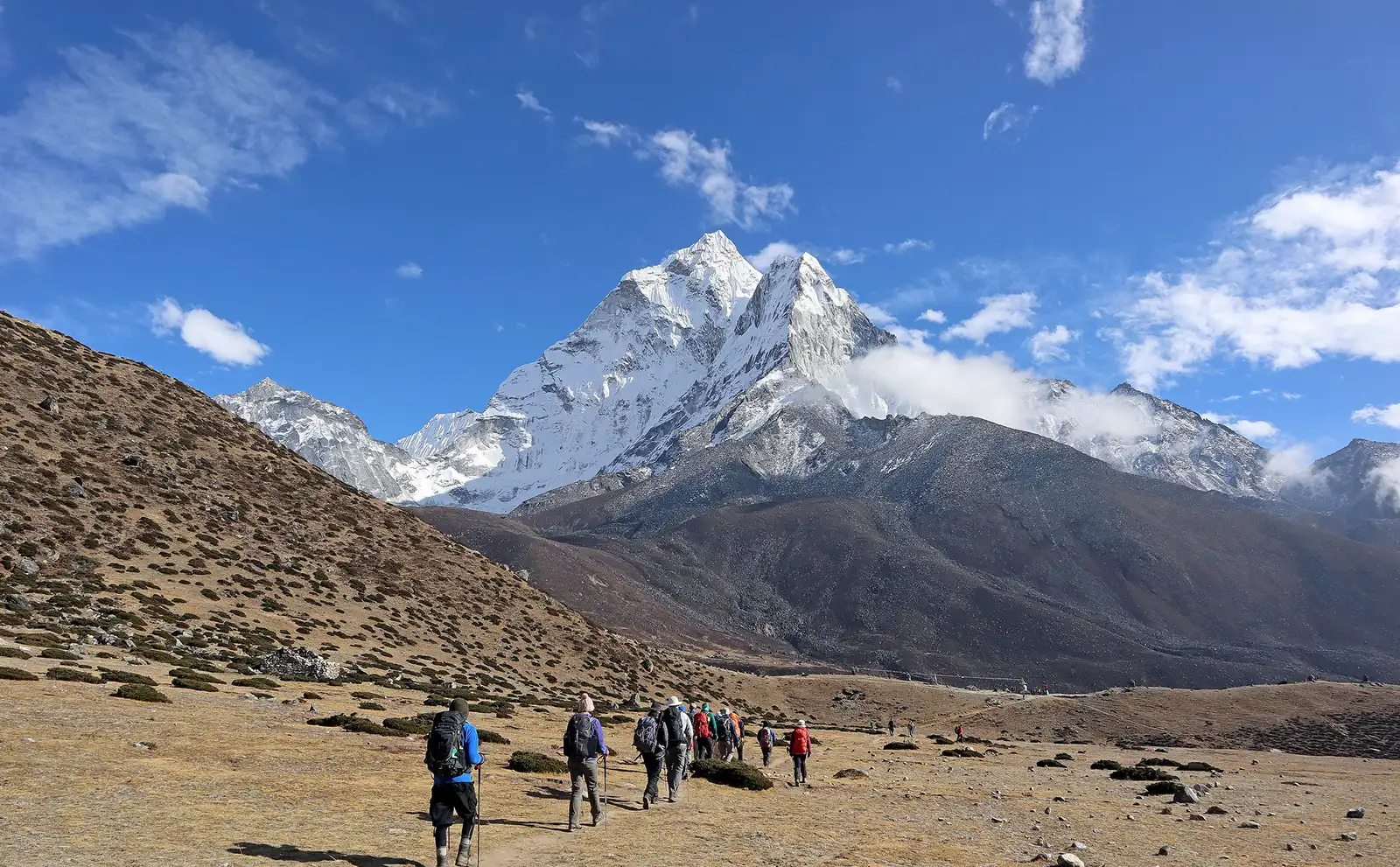
FAQs
WHERE IS THE EVEREST BASE CAMP LOCATED?
Everest Base Camp is located in the Solukhumbu district of Nepal.
HOW LONG IS THIS TREK?
There are different trekking options. But the classic Everest Base Camp Trek can be done in 15 days from Kathmandu.
WHICH IS THE BEST SEASON TO GO ON EVEREST BASE CAMP TREKKING?
Spring is the best time to do this trek, as clear weather ensures better mountain views. However, the trek can also be done in autumn and during the monsoon.
HOW FIT DO I NEED TO BE?
Any healthy individual can do this trek as it is only moderately challenging.
HOW LONG DO WE NEED TO WALK EVERY DAY?
You will need to walk 6-7 hours a day on average.
WHAT PERMITS DO I NEED TO TAKE?
You need two types of permits: Sagarmatha National Park permits and TIMS CARD.
WHAT IS THE HIGHEST ALTITUDE ON THIS TREK?
Kalapatthar (5640m) is the highest point of this trek.
HOW IS THE ACCOMMODATION?
There are good teahouses in the Everest Region with warm and comfortable rooms.
DO I GET AN INTERNET FACILITY?
Yes, you get an Internet facility in most places on the trek. But lodges often charge separately for Internet browsing.
IS THERE AN ATM FACILITY ON THE TREK?
There are ATM facilities only in Lukla and Namche Bazaar.
DO I NEED TO HIRE A GUIDE/AGENCY FOR THIS TREK?
You are free to trek independently. But we advise you to take along a guide or a porter, given the complex topography and unpredictable weather. Hiring an agency is even better as it will take care of everything.
WHAT ARE THE OTHER WEBSITE I CAN COLLECT INFORMATION ABOUT EVEREST BASE CAMP TREKKING?
You can visit the website below for further information :
TAAN: https://www.taan.org.np/
Nepal Tourism Board: https://ntb.gov.np/
Tourism Ministry Nepal: https://www.tourism.gov.np/
